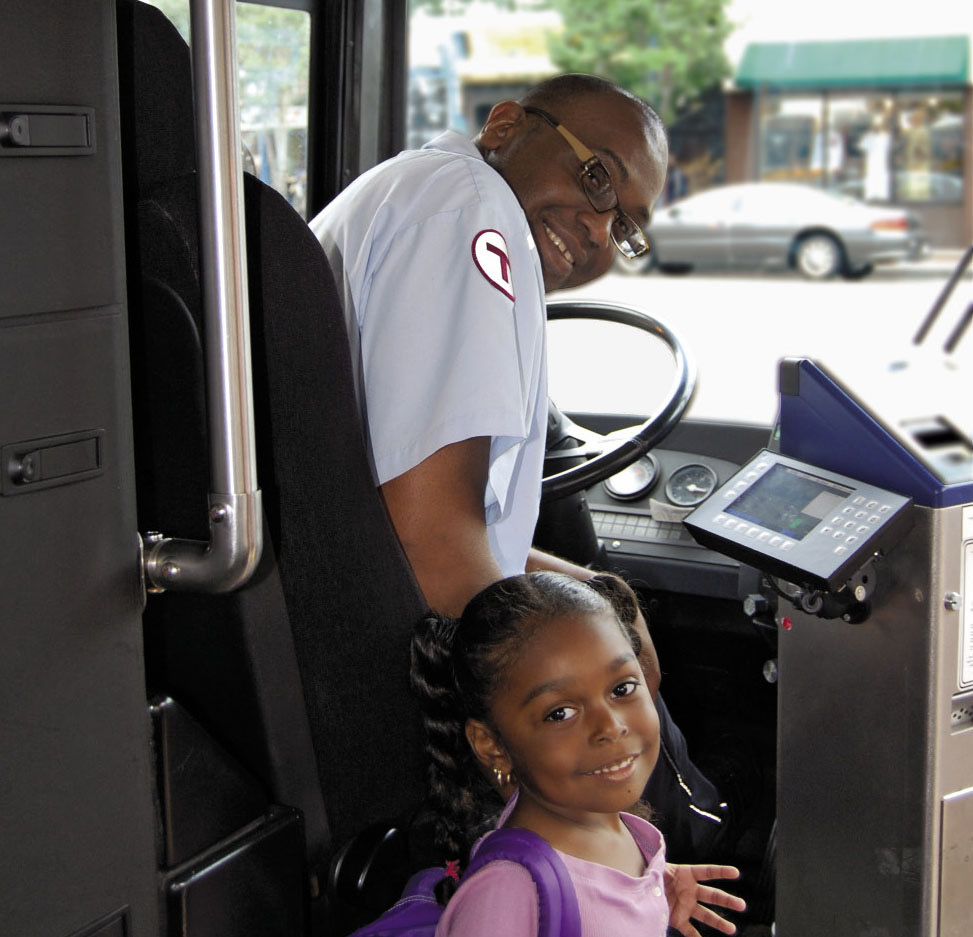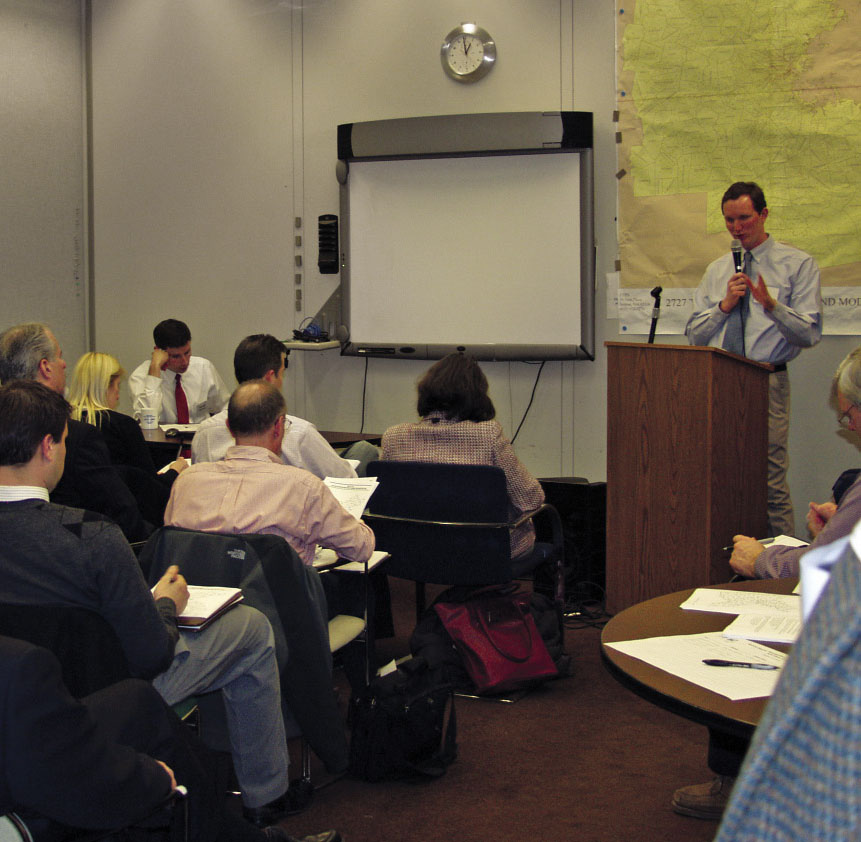1 A public hearing was required on a federal-aid highway project if the proposed project would bypass or travel through a municipality.
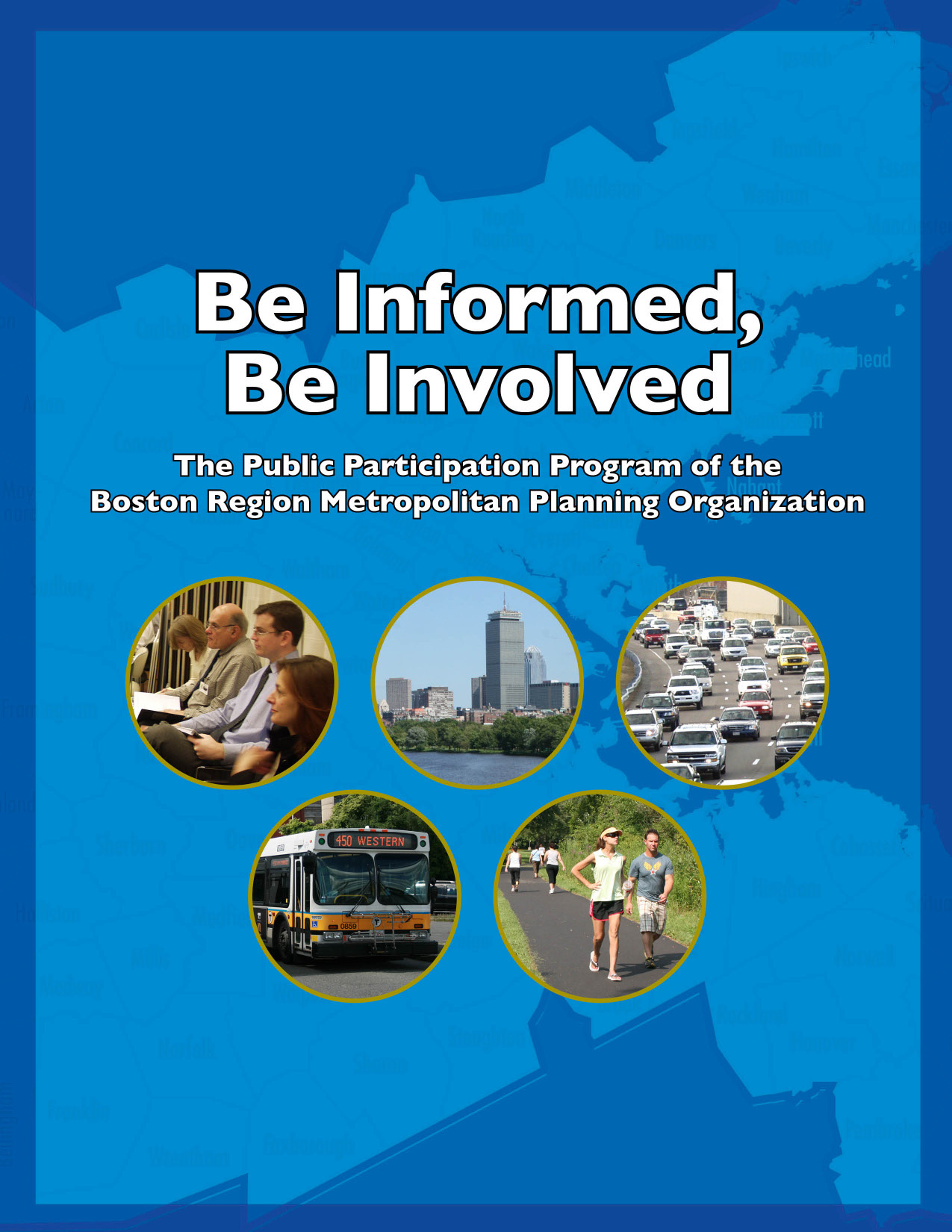
PAGE INTENTIONALLY BLANK
BE INFORMED, BE INVOLVED
THE PUBLIC PARTICIPATION PROGRAM OF THE
BOSTON REGION METROPOLITAN PLANNING ORGANIZATION
BOSTON REGION MPO
Diverse Region – Working Together
People, Information, Strategies
Adopted June 28, 2007
Revised April 1, 2010
Updated May 2012
PAGE INTENTIONALLY BLANK
TABLE OF CONTENTS
Introduction . . . . . . . . . . . . . . . . . . . . . . . . . . . . . . . . . . . . . . . . . . . . 1
The Boston Region MPO and Its Transportation Planning
The Boston Metropolitan Area . . . . . . . . . . . . . . . . . . . . . . . . . . 2
What Is the Boston Region MPO? . . . . . . . . . . . . . . . . . . . . . . . 4
MPO Membership . . . . . . . . . . . . . . . . . . . . . . . . . . . . . . . . 6
MPO Plans and Programs . . . . . . . . . . . . . . . . . . . . . . . . . . 7
Certification Documents . . . . . . . . . . . . . . . . . . . . . . . . . 7
Public Participation Program
The Purpose of Public Participation . . . . . . . . . . . . . . . . . . . . . . 9
History and Regulations . . . . . . . . . . . . . . . . . . . . . . . . . . . . . . . 9
Objectives for Public Participation . . . . . . . . . . . . . . . . . . . . . . . 9
Members of the Public . . . . . . . . . . . . . . . . . . . . . . . . . . . . . . . 10
The Transportation Equity Program . . . . . . . . . . . . . . . . . . . . . 11
Representation on Decision-Making and Advisory Boards . . . 13
Development of the Public Participation Program . . . . . . . . . . 14
Ways to Be Informed and Be Involved
Methods of Public Participation . . . . . . . . . . . . . . . . . . . . . . . . 14
How to Be Informed . . . . . . . . . . . . . . . . . . . . . . . . . . . . . . . . . 14
How to Be Involved . . . . . . . . . . . . . . . . . . . . . . . . . . . . . . . . . 16
Development of Certification Documents . . . . . . . . . . . . . . . . 21
Formal Public Review and Comment Periods . . . . . . . . . . 21
Amendments and Administrative Modifications . . . . . . . . . 22
Supplementary Information
Evaluation of the Public Participation Program . . . . . . . . . . . . 23
Related Outreach Conducted by Individual MPO Members . . 24
Federal Transit Administration Public Hearing Requirements . 25

INTRODUCTION
This document serves as a guide to how members of the public can be informed about, and involved in, the transportation decisions that shape our region. It will first provide some background by briefly describing the Boston region’s transportation system, explaining the nature and composition of the Boston Region Metropolitan Planning Organization (MPO), and outlining the kinds of critical transportation decisions the MPO makes. Then it will explain how members of the public can be involved in these decisions. Being involved is important because a well-informed and outspoken public leads to better transportation decisions for us all.
The communities that make up our region are shown below.
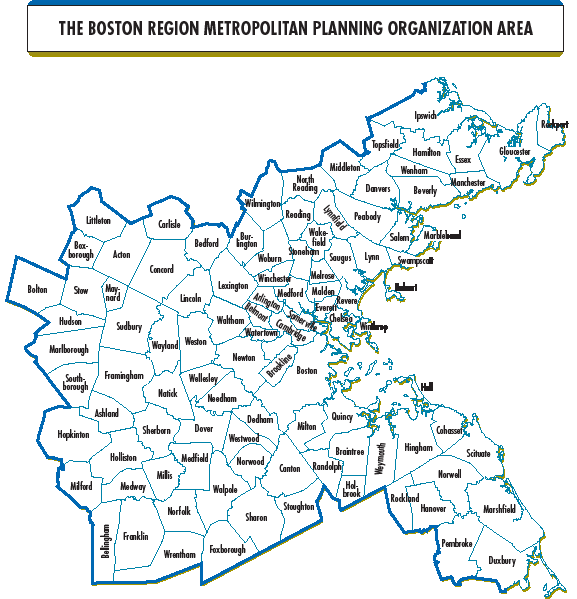
THE BOSTON REGION MPO AND ITS
TRANSPORTATION PLANNING
The Boston Metropolitan Area
The MPO region consists of 101 cities and towns in eastern Massachusetts predominantly within the 20-mile radius extending from the city of Boston westward to the communities along Interstate 495, to Ipswich on the North Shore, and to Duxbury on the South Shore. This area of nearly 1,500 square miles is a diverse place where there is a significant concentration of colleges and universities, office buildings and factories, and historical and recreational destinations that support the region’s strong economy. There are historic seaports, world-renowned parks, and pleasant neighborhoods. More than 3 million people inhabit the metropolitan area and about 1.8 million people work here. It encompasses areas ranging from rural to suburban to some of the densest urban communities in the United States.
Connecting the region’s people and places is a robust transportation system serving the needs of people from all walks of life and of different abilities. The system also helps deliver the goods and supplies we rely upon. The transportation planning for our region responds to these different needs by developing solutions that fit the area’s diverse demographic, cultural, economic, environmental, and mobility contexts.
One element of our transportation system is a well-developed roadway network. In the Boston region there are more than 23,000 lane-miles of roadways accommodating many types of users. A lane-mile is an area of pavement one mile long and one lane wide. There are also more than 1,500 bridges in the region. On these roads and bridges vehicles travel about 70 million miles on a typical weekday. Roads are not just for vehicles, though. Sidewalks and bicycle lanes are also very important for connecting people and places. About 50% of the region’s non-interstate roads have a sidewalk on at least one side, and about 2% have bicycle accommodations.
The region is also home to one of the oldest and most comprehensive transit systems in the United States. This system is made up of rapid transit, local bus, streetcar, express bus, commuter rail, and commuter boat services. It provides for more than 1.3 million trips each weekday, making it a vital supporter of our economy and a means of affordable transportation for many people. A key component of the transit system is a paratransit service, which provides door-to-door transportation to eligible people who cannot use general public transportation some of the time or anytime because of a physical or cognitive disability. Opposite is a map showing some of the major highway and rail infrastructure in the region.
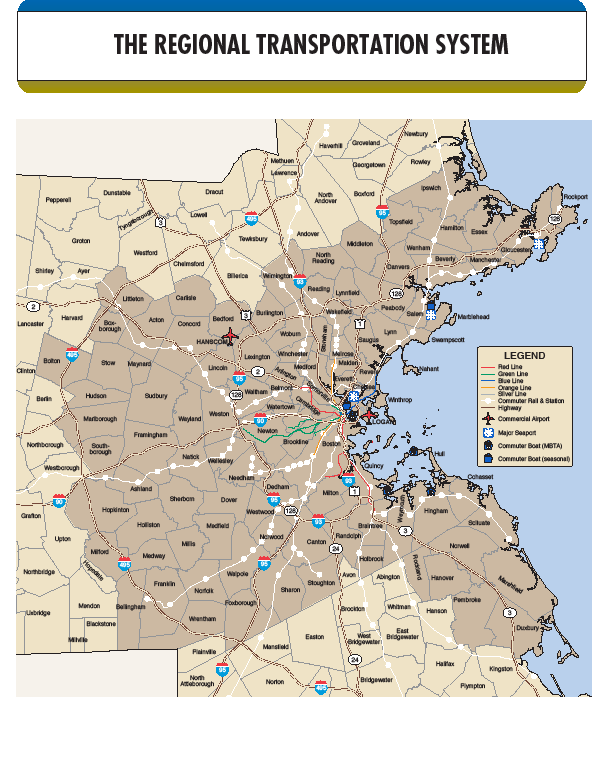 What Is the Boston Region MPO?
What Is the Boston Region MPO?
Improving the transportation system described in the previous section is one responsibility of the Boston Region Metropolitan Planning Organization (MPO). At a basic level, the Boston Region MPO is a board of 22 voting members that decides how to spend federal transportation funds. The majority of these funds goes to capital highway and transit projects. In order to spend these funds wisely, the MPO conducts transportation planning and engages the participation of the public in that planning. Consistent with federal law, the MPO’s work is continuing, comprehensive, and cooperative, which is why it is sometimes called the 3C process.
The Boston Region MPO is not a unique entity. More than 380 MPOs have been established throughout the United States to conduct transportation planning in urbanized areas of more than 50,000 people. Each MPO has five core functions, which are defined as follows in The Transportation Planning Process: Key Issues, a publication of the Federal Highway and Federal Transit Administrations:
• Establish a setting: Establish and manage a fair and impartial setting for effective regional decision making in the metropolitan area.
• Identify and evaluate alternative transportation improvement options: Use data and planning methods to generate and evaluate alternatives. This work is described in the annual Unified Planning Work Program.
• Prepare and maintain a Long-Range Transportation Plan: Develop and update a Long-Range Transportation Plan for the metropolitan area covering a planning horizon of at least twenty years that fosters mobility and access for people and goods, efficient system performance and preservation, and good quality of life.
• Develop a Transportation Improvement Program: Develop a short-range (four-year) program of transportation improvements based on the Long-Range Transportation Plan; the Transportation Improvement Program should be designed to achieve the area’s goals, using spending, regulating, operating, management, and financial tools.
• Involve the public: Involve the general public and offer affected constituencies opportunities to participate in decision-making in the four essential functions listed above.
These functions and other responsibilities of MPOs are described in federal laws and the regulations that implement the laws. Transportation planning requirements, and specifically the 3C process described earlier, date back to the Federal-Aid Highway Act of 1962. The laws and regulations guiding transportation planning are periodically revised; the most recent federal transportation law is SAFETEA-LU (the Safe, Accountable, Flexible, Efficient Transportation Equity Act: A Legacy for Users). While the core functions and responsibilities are the same for all MPOs, each MPO is free to establish its own membership structure and many other aspects of how it accomplishes its work. These aspects of the Boston Region MPO are laid out in a Memorandum of Understanding (MOU) among the 22 voting members.
The MOU establishes the membership of the MPO, the committees, the process used to develop certification documents, voting rules, and more. The MOU also assigns much of the responsibility for carrying out the work of the transportation planning process to the Central Transportation Planning Staff (CTPS), under the direction of the MPO. The complete MOU can be downloaded from the MPO’s website, www.bostonmpo.org.

MPO Membership
A key issue addressed when the MPO adopted a new Memorandum of Understanding in July 2011 was membership. Voting membership was increased from 14 to 22 members, with the additional seats going to municipalities and the Regional Transportation Advisory Council. The municipal membership of the MPO now consists of the City of Boston with two permanent seats, two cities and two towns elected at large, and eight cities or towns elected from, respectively, each of the eight Metropolitan Area Planning Council subregional groups. The elected municipalities are elected by a vote of all 101 cities and towns of the MPO area. A map of the subregions can be downloaded from the Metropolitan Area Planning Council’s website, www.mapc.org. Elections for municipal seats are held each fall. Elected municipalities serve three-year terms.
The MPO membership is composed of state transportation agencies and regional organizations and authorities, cities, and towns. The voting members are:
• Massachusetts Department • City of Beverly
of Transportation (3 votes)
• Massachusetts Bay Transportation • City of Everett
Authority (MBTA)
• MBTA Advisory Board • City of Newton
• Massachusetts Port Authority (Massport) • City of Somerville
• Metropolitan Area Planning Council (MAPC) • City of Woburn
• Regional Transportation Advisory Council • Town of Arlington
• City of Boston (2 votes) • Town of Bedford
• Town of Braintree
• Town of Framingham
• Town of Lexington
• Town of Medway
• Town of Norwood
Additionally, the Federal Highway Administration (FHWA) and Federal Transit Administration (FTA) are non-voting members of the MPO.
MPO Plans and Programs
The end products of the MPO’s work are represented in studies, reports, technical memoranda, and data on transportation issues in the region, and a set of core regionwide plans, called certification documents, produced on a regular basis. These products are developed by the Central Transportation Planning Staff at the direction of the MPO. The staff also develop and maintain technical tools, such as a travel model, that help the MPO conduct its work.
Certification Documents
The three core “certification documents” required of each MPO are the Unified Planning Work Program (UPWP), Long-Range Transportation Plan (LRTP), and Transportation Improvement Program (TIP). These documents are the plans that guide the allocation of federal transportation dollars in our region. They are called certification documents because they are required of each MPO in the country in order to be certified by the federal government as eligible to program federal transportation funds.
The UPWP outlines the planning activities and budget of the MPO. It covers a one-year period beginning October 1, the start of the federal fiscal year. The LRTP is a statement of the ways in which the MPO plans to invest in transportation for the next 20 or more years. It explains the MPO’s policies and goals, summarizes transportation system needs, estimates the future financial resources that will be available to improve the system, and identifies important projects that will help the MPO achieve its goals. Projects that add capacity to the system or, in the Boston region, cost more than $10 million must be identified in the LRTP before they can be programmed for construction. The LRTP is updated every four years. The LRTP is implemented through the TIP. It allocates funding for transportation system improvements over a four-year period. The TIP is updated each year on the same schedule as the UPWP.
The figure below depicts how the three certification documents are related to each other and how they are related to other documents developed by the MPO (blue) and by state and regional agencies, such as the Massachusetts Bay Transportation Authority (green).
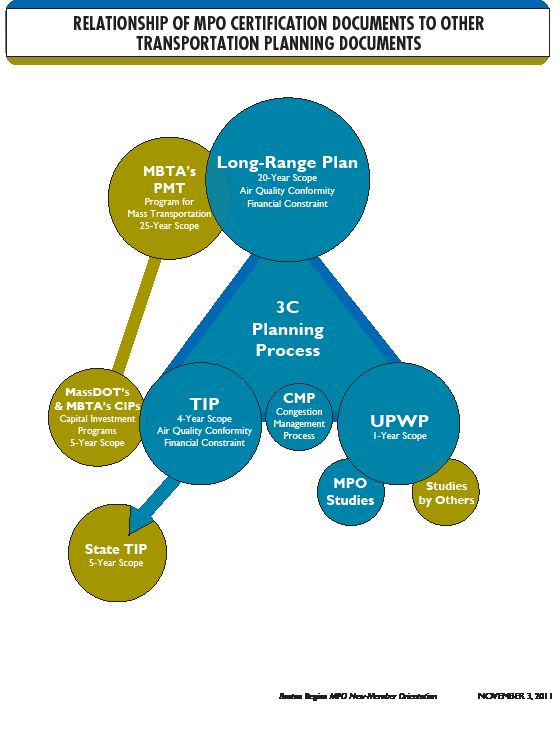
PUBLIC PARTICIPATION PROGRAM
Underlying all of the MPO’s work is the participation of the public. This section describes the MPO’s policies to provide for public participation throughout the transportation planning process. The following section will describe the ways in which the public can be informed about, and involved in, transportation decisions in our region.
The Purpose of Public Participation
Public participation is integral to the transportation planning work undertaken by the MPO. Meaningful public participation in the MPO’s work improves decision making by helping illuminate all of the transportation, social, economic, and environmental benefits and drawbacks of transportation decisions.
History and Regulations
Public participation in transportation has been evolving since the Federal Aid Highway Act of 1950 first required states to hold public hearings on some projects.1 The Federal Highway Act of 1962 created the 3C process, requiring transportation planning in urban areas to be cooperative, comprehensive, and continuing. Several federal transportation bills later, the Intermodal Surface Transportation Efficiency Act of 1991 (ISTEA) required MPOs to adopt a formal public participation process. The Boston Region MPO’s process embraces the letter and spirit of this requirement, and the MPO has developed a program intended to meet the needs of all interested parties in the region.
Objectives for Public Participation
The following principles, developed in conjunction with current best-practice standards for public participation, guide the program. These, and appropriate quantitative and qualitative measures, will be considered in the MPO’s reviews of the effectiveness of this Public Participation Program:
• Promote respect among all transportation constituents
• Provide comfortable and meaningful opportunities for involvement
• Be responsive to participants’ interests and needs for information
• Offer substantive and timely work that supports constructive input
• Provide a predictable process that is understandable
• Adopt new avenues of communication
• Include all constituencies, bolstering outreach to minority, low-income, elderly, and youth communities, persons with limited English proficiency, and persons with disabilities
• Provide for flexibility
Members of the Public
The word “public” has been used many times so far in this document, and it is important to explain what is meant by it. As described by the FHWA and FTA, “the public includes anyone who resides, has an interest in, or does business in a given area potentially affected by transportation decisions. This includes both individuals and organized groups.”
Among the individuals and groups that the Boston Region MPO reaches out to and invites to share their views prior to decision making are:
• Members of the general public
• Regional Transportation Advisory Council members
• Low-income and minority residents and organizations representing them, Transportation Equity Program contacts, persons with limited English proficiency, youth, and elderly
• The Access Advisory Committee to the MBTA and the MBTA Rider Oversight Committee
• Local officials, including elected boards, town administrators, planning directors, directors of departments of public works, and conservation commission agents
• State legislators
• Affected public agencies, including environmental and housing agencies
• Groups representing pedestrians, bicyclists, users of public transportation, environmental resources, business interests, and transportation advocacy interests
• Representatives of public transportation employees, private transportation providers, and providers of freight transportation services
• Agencies and officials responsible for other planning activities (state and local planned growth, economic development, environmental protection, airport operations, and freight movements), and federal land management agencies
The MPO also coordinates transportation planning with the four other MPOs in the Boston Urbanized Area (the urbanized area extends beyond the boundaries of the MPO and encompasses all of the areas of concentrated development surrounding the city of Boston). The other MPOs are the Merrimack Valley, Northern Middlesex, Old Colony, and Southeastern Massachusetts metropolitan planning organizations.
The Transportation Equity Program
The MPO pays special attention to consultation with low-income and minority residents and with groups representing their interests and those of the elderly, youth, and persons with limited English proficiency. This work is referred to as the MPO’s Transportation Equity Program. Through the program the MPO identifies the transportation needs of these populations and promotes their involvement in the planning process.
The program focuses on direct outreach to organizations serving environmental justice areas in the region. These organizations and other community contacts are involved in, and knowledgeable about, the transportation issues and needs of their areas. Contacts include social service organizations, community development corporations, regional employment boards, civic groups, business and labor organizations, transportation advocates, environmental groups, and environmental justice and civil rights groups. The MPO’s process for working with these community organizations consists of meeting in their communities, gathering information, summarizing needs, sharing information and input, and providing feedback once communication is undertaken.
The MPO holds meetings for the public at large every year on various topics, which include forums for discussing certification documents and UPWP studies. Transportation equity contacts are encouraged to attend and to provide input at each of these events. The MPO also holds periodic meetings that focus on environmental justice and gives presentations on its Transportation Equity Program whenever requested to by a community organization. Transportation equity contacts are notified of public review periods and are encouraged to provide input.
The MPO staff also conducts surveys to gather input from persons living in environmental justice neighborhoods and from the transportation equity contacts. The staff summarizes this input, and the comments from the events discussed above, and distributes it to MPO members.
The MPO also conducts technical analyses to better understand the impacts of the transportation system and transportation plans on environmental justice areas. For the MPO’s current Long-Range Transportation Plan, Paths to a Sustainable Region, the MPO staff performed a systemwide analysis of current conditions, the set of projects that were already funded by the MPO and under construction, and the set of projects recommended in the LRTP. The analysis focused on mobility, accessibility, and emissions for communities with a high proportion of low-income and minority residents.
The MPO also integrates environmental justice concerns into the planning process by using environmental justice as a criterion in its planning documents and by examining environmental justice issues in greater detail. The potential impact of a proposed project in an environmental justice area is a criterion in the LRTP and TIP project-ranking processes. The MPO staff gives projects that are estimated to benefit environmental justice areas positive ratings and projects that may burden these areas negative ratings. The MPO considers these ratings when deciding what projects should be listed in the LRTP or TIP, and which should receive funding.
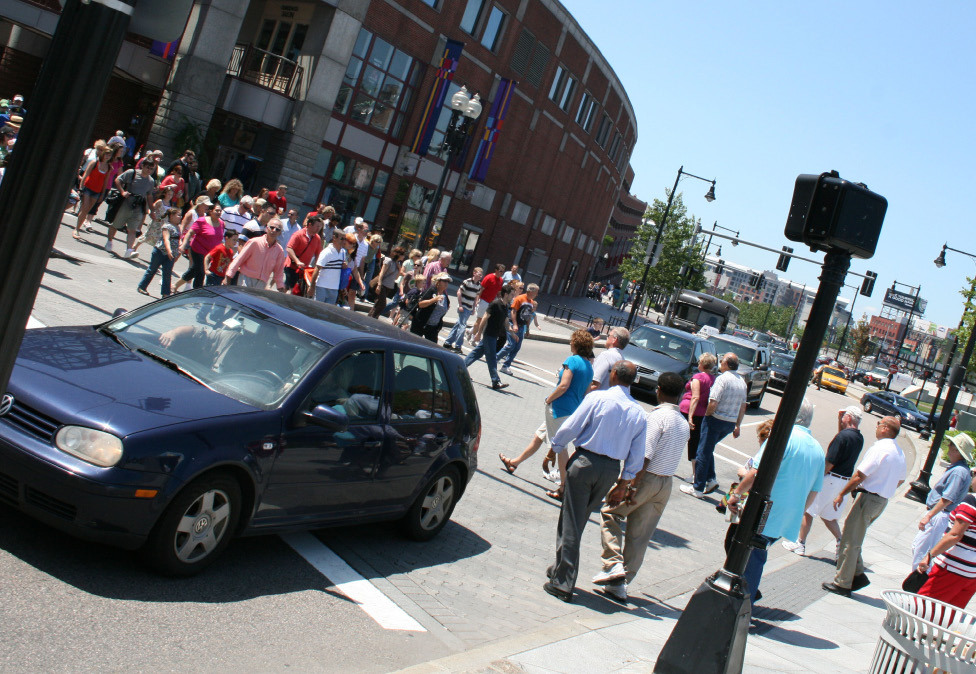
Representation on Decision-Making and Advisory Boards
The Boston Region MPO Memorandum of Understanding charges MPO member entities with the responsibility of communicating the transportation needs of their minority constituents to the full MPO. Currently, four of the thirteen municipalities on the MPO include identified environmental justice areas: Boston, Everett, Framingham, and Somerville.
There are several advisory boards to the MPO. The Regional Transportation Advisory Council is an independent body that provides advice and input to the MPO. The Advisory Council determines its own membership. Currently, there are several municipalities on the Council that contain an environmental justice area: the MPO municipalities (Boston, Everett, Framingham, and Somerville), as well as Cambridge, Revere, and Quincy.
There are three policy advisory boards for the MBTA – the Access Advisory Committee to the MBTA (AACT), the Rider Oversight Committee (ROC), and the MBTA Advisory Board. The MBTA Advisory Board is a creation of the MBTA’s enabling legislation and is composed of the chief elected officials of the 175 cities and towns served by the MBTA. Their mission is to provide public oversight of the MBTA as well as technical assistance and input on behalf of the 175 members. The MBTA Advisory Board is a member of the MPO.
The MBTA Rider Oversight Committee is composed of eight members representing various advocacy groups, eight senior MBTA managers, eight public members, and three public alternate members. The committee seeks to maintain a diverse membership representative of the MBTA’s ridership.
AACT is a consumer organization composed primarily of people with disabilities, senior citizens, and representatives of human services agencies. It is an independent organization that works closely with the MBTA to provide for accessibility in the MBTA system, as guaranteed by the Americans with Disabilities Act. AACT provides a public forum for discussion of MPO issues and topics, including the certification documents during their development, and is invited to participate in the development, review, and comment processes for all certification documents. All AACT members receive MPO notices and flyers in their regular monthly informational mailings. AACT officials and interested members are also sent notices through MPOinfo, and they often attend MPO meetings and participate in MPO-sponsored meetings. The Massachusetts Commission for the Blind receives MPO notices and invitations to participate and frequently tapes this information for distribution to users of its services.
Development of the Public Participation Program
The MPO’s Public Participation Program adopted in 2007 and the 2010 amendment were developed in consultation with members of the public and other interested parties. Each had a 45-day public review and comment period. This update incorporates changes necessitated by the MPO’s 2011 Memorandum of Understanding. While it incorporates new background information about the MPO region, it makes no substantive changes to the MPO’s Public Participation Program. This Program is posted on the MPO’s website and is distributed upon request in accessible formats.
The MPO reviews the Public Participation Program’s progress and effectiveness on an ongoing basis. The evaluation uses both quantitative and qualitative measures, such as level of event attendance, number of comments received, use of the website, the level of comfort with process and outcome, and sense of fair treatment. Evaluations include written and verbal comments provided by participants and event exit surveys asking for participants’ views on the process. The MPO may elect to modify the Public Participation Program.
WAYS TO BE INFORMED AND BE INVOLVED
This portion of the Public Participation Program describes specific actions taken by the MPO to engage the public in its transportation planning process.
Methods of Public Participation
The MPO has a variety of approaches to providing for communication and consultation with interested parties and members of the public and is continually working to improve its outreach. The tools used by the MPO to communicate with the public are listed below under the heading “How to Be Informed.” The tools used by the MPO to interact and consult with the public and other stakeholders are listed below under the heading “How to Be Involved.” Providing for accessibility and accommodations for persons with disabilities is integral to all of the MPO’s methods of public participation. The public participation process is underway all year long.
How to Be Informed
The methods described below are conducted throughout the year as part of the MPO’s ongoing exchange of information about transportation planning in the region.
Website
The MPO’s website, www.bostonmpo.org, is the primary location for current information about the MPO and all MPO activities. Its function is to make information available quickly and conveniently. It also serves as an avenue for input, with buttons for submitting comments and views, particularly on draft documents and studies. It has a translation tool that can translate many of the posted materials into numerous languages.
The website also contains a meeting calendar with agendas and materials for all meetings of the MPO, its committees, the Regional Transportation Advisory Council, and the Access Advisory Committee to the MBTA. Agendas are available in HTML format, in addition to PDF, so that screen readers are able to interpret them. The current LRTP, TIP, and UPWP can also be found on and downloaded from the website, along with reports and memorandums prepared by the MPO.
TRANSREPORT
TRANSREPORT is well known as the central news source for the region’s transportation issues and has a circulation of more than 2,500. It is available in several formats: print copies, accessible formats, online at the MPO’s website, and by e-mail. From time to time, it includes special inserts focusing on a timely planning initiative, often with a tear-off postcard for submitting comments. TRANSREPORT also notes informational materials available on the MPO’s website so that individuals without Web access may request print copies.
Newspapers
Press releases are sent to newspapers in the region to announce open houses, workshops, other public meetings, milestones in the development of certification documents, and the availability of documents for public review. Press releases are translated into Spanish and sent to Spanish-language media. This broader media coverage is intended to reach members of the public who may not usually take part in transportation planning.
 E-mail
E-mail
MPOinfo is the MPO’s one-way e-mail listserve. It is used to announce public meetings, the availability of materials and documents for public review, and other information and milestones. MPOinfo has approximately 2,000 subscribers, including the general public, local officials, chambers of commerce, legislators, and print media. Subscribers are added to MPOinfo when they provide their e-mail address to the MPO, often through sign-in sheets at public meetings.
Social Media
Social media tools such as YouTube and Twitter have become important outreach methods utilized by MPOs and state DOTs, including MassDOT. The Boston Region MPO uses Twitter under the name @BostonRegionMPO to announce important meetings, provide notice of the availability of draft documents and complete studies, and facilitate discussion of the MPO among the general public. These tools can help the MPO reach new individuals and groups, and their use is consistent with the MPO’s public participation objective calling for the use of new avenues of communication. The MPO also uses YouTube to share video, such as candidate statements for an MPO election.
Contact Us
MPO staff members are available and pleased to answer your questions. A staff directory can be found on the MPO’s website. You can also reach the MPO staff by calling 617.973.7100 or by e-mail at publicinformation@ctps.org. In addition, the MPO can be reached by writing to Boston Region MPO, 10 Park Plaza, Suite 2150, Boston, MA 02116.
Materials in Accessible Formats
Accessibility is a priority of the MPO’s Public Participation Program. Certification documents and other reports and informational materials are available in varied formats. Consideration is given to the use of formats other than PDF, as those formats improve accessibility for people with disabilities. The public can request documents in accessible formats by contacting the staff at 617.973.8853 (voice), 617.973.7089 (TTY), 617.973.8855 (fax), or publicinformation@ctps.org.
How to Be Involved
The methods described below are key avenues for public input into transportation planning. These formats promote a consultative environment and an exchange of information and ideas. These activities are sometimes conducted in cooperation with sponsoring entities, such as municipalities, MAPC subregions, the Regional Transportation Advisory Council, and community groups. Many are ongoing. Public discussions are scheduled to coincide with the development of the certification documents. The figure opposite shows the MPO’s general schedule for this work.
Regional Transportation Advisory Council
One of the best ways to become involved in the MPO’s work is through its Regional Transportation Advisory Council. Also known as the “Advisory Council,” the group was created and is supported by the MPO to be a conduit for public input. It is responsible for generating broad and timely participation by bringing together representatives of advocacy groups for all modes, business leaders, and municipal and regional representatives concerned with transportation, land use, development and the economy, the environment, the elderly, and persons with disabilities. Approximately 55 members representing these entities are on the Advisory Council. The Advisory Council typically meets the second Wednesday of each month at 3:00 PM in the State Transportation Building. Those interested in joining the Advisory Council should contact the MPO at publicinformation@ctps.org.
Attend an MPO or AACT Meeting
The Boston Region MPO meets on a regular basis to handle day-to-day technical and policy matters and to approve MPO documents and other work. MPO meetings are also a forum for reporting on the State Implementation Plan (the plan for achieving air quality goals) and a method of supporting the MBTA’s public review requirements (see Federal Transit Administration Public Hearing Requirements, below). The MPO typically meets the first and third Thursdays of each month at 10:00 AM in the State Transportation Building in Boston. It also meets on a quarterly basis at locations outside of Boston. Each meeting has time reserved for comments from the public.
The Access Advisory Committee to the MBTA (AACT) meets monthly to provide input to the MBTA on accessibility issues and other matters of importance to the region’s disability community. Visit the MPO’s website (www.bostonmpo.org) to find the most up-to-date schedule information for the MPO, the Advisory Council, and AACT, as well as their committees.
MPO-Sponsored Public Discussions
The MPO also holds public meetings throughout the region to present information and gather feedback on important documents and other planning work. Meetings often feature a presentation from a staff member and a discussion with and among the attendees. Visualization tools, such as maps and graphic displays, facilitate discussion and understanding. These meetings are typically scheduled in the winter to explain the MPO’s process for developing its certification documents (an example is the MPO’s TIP-Building Workshops) and in the late spring or early summer during the MPO’s public review periods for its draft certification documents.
The MPO also holds Transportation Equity Forums for discussing certification documents and UPWP studies. Transportation equity contacts are encouraged to attend and to provide input at these events. The MPO also gives presentations on its Transportation Equity Program whenever requested by a community organization.
The eight Metropolitan Area Planning Council subregional groups are updated regularly by the MPO staff about the development of the certification documents and other transportation studies affecting their region. A schedule of subregional group meetings is available on the Metropolitan Area Planning Council’s website (www.mapc.org).

Interagency Consultations
In addition to the public meetings described above, the MPO also consults with officials and agencies with activities and interests that overlap, or that are affected by, transportation, in order to provide opportunities for gathering input from these agencies and for coordinating between MPO planning and planning underway by others. Methods for these consultations include notification of the development of certification documents, requests for reviews, and comparisons of information. For example, the agencies and officials responsible for other planning activities, such as state and local planned growth, economic development, environmental protection, historic resources, airport operations, freight movements, and federal land management agencies are invited to consult with the MPO during the development of the LRTP.
Public Meeting Notification
Public notification of meetings is provided in a variety of ways, such as legal notices, press releases in regional and local newspapers, flyers, posters, correspondence, and e-mail messages. Notifications of MPO, Advisory Council, and AACT meetings are provided on the MPO’s website no later than 48 hours prior to a meeting. It is the policy of the MPO to post a meeting notification, in the form of a meeting agenda, seven days prior to the meeting whenever possible. Meeting notifications are available in accessible formats, such as Braille, large print, and audiotape. Organizations providing support for persons with disabilities also forward MPO notices to their constituents in accessible formats.
Providing for Accessibility
Meeting locations are accessible to people with disabilities and via public transportation. Assistive listening devices and large-print materials are available at all meeting sites. A sound amplification system is also used at all public meetings. Upon advance request, every effort is made to prepare materials in other formats and in languages other than English, and to provide interpreters in American Sign Language and other languages. For assistance or accommodations, contact the MPO, preferably two weeks before the meeting, at 617.973.7141 (voice), 617.973.7089 (TTY), 617.973.8855 (fax), or pwolfe@ctps.org.
Activities are also scheduled on varying dates, at varying times, and at locations throughout the region, with the intention of providing convenient opportunities for participation.
Submit a Comment
Comments on the MPO’s work are accepted at all times via our website, phone, TTY, e-mail, and U.S. mail. Details of this contact information are provided in the “How to Be Informed” section.
The MPO’s website has a “Comment” button that allows people to provide feedback. This button can be utilized to provide a formal comment to the MPO about one of its certification documents during the formal public review period, to ask questions, or to provide more general feedback.
Surveys
The MPO periodically conducts surveys through its website (www.bostonmpo.org). A current example is the Transportation Equity Survey, which collects information about the concerns and ideas of low-income and minority communities in the region.
Host a Meeting (Invite Us Over)
The MPO has an “Invite Us Over” program, which makes MPO representatives available to meet with groups and institutions interested in learning about the metropolitan planning process and MPO work underway. These meetings offer groups an opportunity to participate in a more informal and convenient way.
Development of Certification Documents
The MPO’s central responsibility is carrying out the 3C transportation planning process for the Boston region, which entails developing the three certification documents. Outreach for the Transportation Improvement Program (TIP) starts in the fall each year. This is when the MPO asks all municipalities to identify their TIP contact and the projects for which they want to provide updated information. This begins the annual exchange of technical information between the MPO and the project proponents in preparation for project evaluations and development of the upcoming TIP. In early winter, the MPO sponsors “How-To” Seminars, with a more technical focus to provide local officials and members of the public explanations of the MPO process for UPWP and TIP development and instructions on how to provide updated information to the MPO staff.
In the early spring, the staff recommends a set of projects to program in the TIP. These projects are most likely to be drawn from the First-Tier List of Projects, which is a small group that received the most points through the MPO’s evaluations and that can be made ready to advertise for construction within the time frame of the upcoming TIP.
Unified Planning Work Program (UPWP) development begins in winter with the “How-To” Seminars. Outreach continues with consultations with each of the MAPC subregional groups to identify other needs.
The Long-Range Transportation Plan (LRTP) is developed every four years. A separate public involvement plan is developed for the LRTP, because it is not developed on a regular schedule like the TIP and UPWP.
The MPO typically seeks to streamline the participation process for the public by jointly circulating the draft TIP and draft UPWP for the documents’ 30-day public review and comment periods. The public comment periods usually begin in the late spring. The MPO then conducts public meetings in locations around the region to provide opportunities for discussion and gathering input.
Formal Public Review and Comment Periods
The MPO approves draft certification documents for a 30-day public review and comment period in the spring. A comment period begins on the date announced in the legal notice of availability of the document. The MPO will make all reasonable efforts to avoid conducting public comment periods and public outreach between December 15 and January 2. Documents and other relevant materials are available on the MPO’s website on the first business day of the public comment period and shortly afterward upon request in compact disc, print, and accessible formats.
Comments are actively solicited in advance of and during review periods for the draft certification documents. A postcard alerting the public to the availability of the draft documents is distributed to legislators, municipal officials (chief elected officials, highway department directors, planning directors or planning board chairs, and conservation commissions), Regional Transportation Advisory Council members, MAPC representatives, Transportation Equity Program contacts, and public libraries in each community.
Announcements of the availability of and public comment periods for the certification documents are also made through legal notices in the major regional English-language newspaper, Spanish-language newspaper, and minority community newspaper and through press releases sent to regional and local newspapers. Meeting notices are placed in TRANSREPORT, posted on the MPO’s website, sent through MPOinfo, and if possible, placed in other print and electronic newsletters in the region. Special efforts are made to reach non-English-speaking residents through community organizations. Announcements include an invitation to comment; dates, places, and times of public meetings to discuss the documents; the date of the close of the public comment period; and instructions on where comments may be submitted. If a public comment period is shortened or waived, the MPO will explain the reason in its public comment notice.
The staff regularly reports to the MPO on all comments received. Written comments, whether received on paper, through the website, or via e-mail, are presented in full and in summarized form to the MPO. The MPO acknowledges receipt of all written comments on certification documents by sending a written reply. If the comment refers to a specific document, a second reply, summarizing the MPO response and providing an explanation, is sent after final adoption of the document. Summaries of verbal comments made at meetings and forums are also prepared. A summary of both types of comments, copies of the original comments, and the MPO’s responses are included as appendices to final documents.
The MPO allows adequate time to review and consider public comments, and to make appropriate adjustments. If significant changes to a draft document are made as it is finalized by the MPO, an additional public comment period may be provided. Following the MPO’s adoption of the documents they are sent to the Federal Highway Administration and Federal Transit Administration for approval.
Amendments and Administrative Modifications
The MPO may amend any of the certification documents. The Advisory Council and affected communities and constituencies are notified of pending amendments. Legal notices of amendments are placed in the region’s major English-language newspaper, Spanish-language newspaper, and minority-community newspaper, and are posted on the MPO’s website. Amendments have a 30-day public comment period in advance of MPO action. There may be exceptions in two types of circumstances. In extraordinary circumstances such as an unforeseen regulatory requirement or funding deadline, the MPO may vote to shorten the public comment period by as much as 15 days. In emergency circumstances, such as an existing or impending severe disruption to the integrity or safety of the transportation system that requires immediate action, or if there is a natural or human-caused hazard or disaster or a need to take immediate action to take advantage of an extraordinary funding opportunity, in the public interest it may be waived.
An extended or an additional public comment period will be provided when a proposed amendment is significantly altered during the initial public comment period (for an extension) or after the close of the initial public comment period (for an additional comment period). The length of an extended public comment period is an additional 15 days from the notification of the extension. An additional public comment period is 30 days from the notification of the additional period.
The Advisory Council is provided an opportunity to develop comments prior to a decision on amendments. The subscribers of the MPOinfo listserve are notified. Municipal and agency representatives and members of the public are invited to attend the MPO meetings at which amendments are discussed and to submit written or oral testimony.
For the Transportation Improvement Program, consistent with federal guidelines, if a project is valued at $5 million or less, the threshold for defining a change to the project as an amendment is a change of $500,000 or more. The threshold for projects valued at greater than $5 million is 10 percent or more of the project value. Changes below these thresholds may be considered administrative modifications. The MPO may act on administrative modifications, and, although no public review period is required, one may be provided at the MPO’s discretion.
Significant changes in funding level are announced through a variety of media, including notice on the MPO’s website and e-mail notification to the municipalities in the region.
SUPPLEMENTARY INFORMATION
Evaluation of the Public Participation Program
Evaluation is a key component of any successful plan. The MPO’s public involvement work is evaluated through the several measures listed below. The sources of data for these measures are meeting attendance logs, surveys distributed at public meetings and “How-To” seminars, records of public comments for each certification document, and data on the total number of hits on the MPO’s website and hits by unique visitors. Among the measures the MPO may track are the following:
• Number of Meeting Attendees
• Share of Attendees at an MPO Meeting Who Are Attending for the First Time
• Number of Comments on the TIP, LRTP, and UPWP
• Geographic Distribution of Comments
• Geographic Distribution of Meeting Attendees
• Share of Municipalities Visited During a Rolling Four-Year Period
• Comments from Low-Income or High-Minority Areas
• Meeting Attendees from Low-Income or High-Minority Areas
• Unique Visitors to MPO Website
• Performance on Survey Questions
• 100% of Meetings Are Handicapped Accessible
• 100% of Meetings Are within One Fourth of a Mile of a Transit Service
Related Outreach Conducted by Individual MPO Members
The MPO agencies and municipalities conduct public participation activities related to MPO activities and their particular agency and program needs. For example, MAPC regularly brings together representatives of the municipalities in each of eight subregions to foster communication and intermunicipal cooperation; they meet monthly to address transportation, land use, conservation, and environmental issues. MPO staff members frequently participate in these discussions to exchange information with and gather input from the subregions. The MBTA conducts extensive outreach in the preparation of the Program for Mass Transportation and the Capital Investment Program, which are intrinsically connected to the Long-Range Transportation Plan and the Transportation Improvement Program. The MBTA also uses public participation in its design and construction projects. MassDOT sets up citizen advisory groups for its corridor and other studies. Elected officials of MPO municipalities conduct outreach for transportation projects and issues. All the member agencies and municipalities engage in environmental review and/or planning activities that call for public processes. Some of these processes are extensive, involving citizen advisory committees, workshops, hearings, and other outreach activities. Members often share information gathered through these processes at MPO meetings. Agencies are encouraged to coordinate their outreach plans, when possible, with MPO workshops to consolidate public involvement activities.
Federal Transit Administration (FTA) Public Hearing Requirements
The MBTA, the region’s FTA Section 5307(c) applicant, has consulted with the MPO and concurs that the public involvement process adopted by the MPO for the development of the Transportation Improvement Program (TIP) satisfies the public hearing requirements that pertain to the development of the Program of Projects for regular Section 5307, Urbanized Area Formula Program, grant applications, including the provision for public notice and the time established for public review and comment.
For FTA projects that are not routine, i.e., Section 5307 applications that require an environmental assessment or an environmental impact statement, the public involvement provided for TIP review is not sufficient. Additional public involvement, as presented in the joint Federal Highway Administration/Federal Transit Administration (FHWA/FTA) environmental regulations, 23 CFR part 771, will be required for grant approval.
